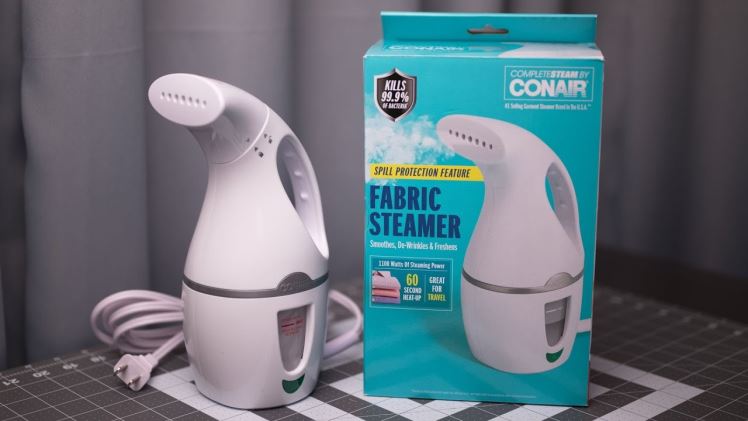Unraveling the Right Setting on Your Conair Compact Fabric Steamer

Intro
Are you struggling to achieve the perfect results when using your Conair Compact Fabric Steamer? One of the key factors in getting the best results is selecting the right setting for your specific fabric. In this guide, we will explore the importance of choosing the correct setting on your Conair Compact Fabric Steamer and provide tips on how to achieve professional results every time.
Understanding Your Conair Compact Fabric Steamer
Delving into the workings of the Conair Compact Fabric Steamer offers a window into its efficiency and user-friendliness, designed to cater to a variety of fabric care needs. This device, celebrated for its compact size, makes it an indispensable tool for those living in spaces where storage is at a premium. Despite its small stature, it packs a powerful punch, capable of delivering a consistent flow of steam that can penetrate even the most stubborn of wrinkles. What sets this steamer apart is its versatility; it is equipped with adjustable settings that allow for customization according to the type of fabric being treated. Whether you’re refreshing a delicate silk blouse or smoothing out creases in a heavy cotton shirt, the steamer’s intuitive design makes it simple to select the appropriate level of steam. Additionally, it boasts a rapid heat-up time, meaning it’s ready to use just moments after turning it on, further emphasizing its convenience for those with busy lifestyles. Its user-friendly features, including a clear water tank for easy monitoring of water levels and a secure, easy-to-grip handle, ensure a comfortable and effective steaming experience. Understanding how to leverage these features can significantly enhance garment care, making the Conair Compact Fabric Steamer a valuable ally in maintaining a well-kept wardrobe.
The Importance of Choosing the Right Setting
The significance of selecting an appropriate setting on your Conair Steamer cannot be overstated. Every fabric in your wardrobe demands a unique level of care, especially when subjected to heat and steam. Not paying attention to this detail can lead to unfortunate outcomes such as damaged textiles or persistent wrinkles that refuse to smooth out. The diversity of materials from delicate silks to robust denims requires a nuanced approach to steaming. Each type of fabric has its own threshold for heat and moisture; recognizing and respecting these limits is key to effective garment care.
Navigating the settings of your steamer to match the fabric at hand is akin to choosing the right tool for a job—it ensures efficiency, safety, and the best possible outcome. For instance, exposing a delicate lace to the highest steam setting might cause irreparable harm, whereas using a low setting on heavy upholstery might not make any dent in the creases. Understanding this balance is vital.
Moreover, the right setting does more than just protect your clothes; it also contributes to the longevity of your steamer. Using inappropriate settings frequently can lead to quicker wear and tear of the device, potentially affecting its performance over time. Hence, mastering the settings not only elevates the appearance of your garments but also safeguards your investment in the Conair Compact Fabric Steamer. It’s a fundamental practice that enhances your steaming endeavors, ensuring that every garment you treat turns out looking refreshed, with its fabric integrity intact.
A Guide to Fabric Types and Corresponding Settings
Navigating the settings on your Conair Compact Fabric Steamer according to the fabric you’re dealing with is crucial for effective and safe steaming. Here’s a concise guide to assist you in making informed decisions for a range of common textiles:
– **Delicate Fabrics**: Fabrics like silk, chiffon, and lace are quite sensitive and can easily be damaged by too much heat. For these, it’s advisable to select the lowest steam setting. Gentle steam ensures the fabric’s integrity while effectively removing wrinkles.
– **Medium Fabrics**: For everyday items made from cotton, linen, or synthetic blends, a medium steam setting is ideal. This level of steam is strong enough to tackle the creases but gentle enough to preserve the quality of the fabric over time.
– **Heavy Fabrics**: Durable materials such as wool, denim, and heavy draperies require a robust approach to remove wrinkles effectively. Setting your Conair Compact Fabric Steamer to its highest steam output can penetrate these thick fabrics, smoothing out creases without the need for laborious ironing.
Remember, the goal is to match the steam output with the fabric’s tolerance to heat and moisture. Before steaming an item for the first time, it’s a good practice to test a small, inconspicuous area of the fabric to ensure the selected setting does not adversely affect the material. Adjusting the settings according to the fabric type not only guarantees the best care for your garments but also extends the life of your steamer by preventing misuse. Following these guidelines, you’ll find maintaining your wardrobe’s appearance and quality becomes a straightforward and satisfying task.
Tips for Effective Steaming
To maximize the effectiveness of your Conair Compact Fabric Steamer, consider adopting a meticulous approach to garment preparation and steaming technique. Begin by ensuring that the clothing item is hung securely on a hanger. This provides a stable surface for you to work on and allows gravity to assist in pulling the wrinkles out as you steam. When introducing the steamer to your garment, maintain a distance of about one to two inches from the fabric. This space is crucial as it prevents the formation of water spots while allowing the steam to do its job effectively.
As you navigate the steamer over the garment, move in a slow, downward motion. This method encourages a thorough penetration of steam, promoting an even and satisfying result. For areas with persistent wrinkles, a light stretching of the fabric with your free hand can provide the tension needed for the steam to smooth out stubborn creases.
When dealing with fabrics that have decorative details such as embroidery, sequins, or buttons, extra caution is warranted. Angle the steamer in such a way that the steam reaches these areas without direct contact. This precaution helps to protect the intricate designs from potential heat damage.
Lastly, incorporating the use of a pressing pad can be beneficial, especially for fabrics that are prone to shine or when you’re aiming for a crisp finish. The pad acts as a barrier, minimizing direct heat exposure while still allowing the steam to eliminate wrinkles. Implementing these tips will not only enhance your steaming experience but also contribute to the overall care and maintenance of your wardrobe.
Maintenance and Care for Your Steamer
Ensuring the longevity and peak performance of your Conair Compact Fabric Steamer involves routine upkeep that goes beyond basic usage. A vital step in this process is to regularly descale the device, particularly if you live in an area with hard water. This can be done by filling the water tank with a mixture of half distilled white vinegar and half water, running the steamer until half the mixture has steamed out, then letting it cool before emptying and rinsing the tank thoroughly. This method helps in removing mineral deposits that could hinder the efficiency of your steamer.
Another critical aspect of maintenance is inspecting the steamer nozzle for any fabric fibers or buildup that may have accumulated over time. A soft-bristled brush can be used gently to clean the nozzle, ensuring that the steam output remains strong and consistent.
Additionally, it’s essential to always use distilled or demineralized water in your steamer to minimize the risk of mineral buildup. Tap water, depending on its hardness, can contribute to quicker accumulation of deposits within the steamer, leading to potential issues with steam production.
To avoid any operational issues, it is also advisable to check the power cord for any signs of wear or damage regularly. If any damage is noticed, cease using the steamer immediately and consult the manufacturer for advice or repairs. Adhering to these maintenance practices not only extends the life of your Conair Compact Fabric Steamer but also ensures it remains a reliable tool for keeping your garments wrinkle-free.
Common Mistakes to Avoid
When it comes to operating your Conair Compact Fabric Steamer, sidestepping certain pitfalls will enhance both the lifespan of your steamer and the condition of your garments. A prevalent error is the misuse of the steamer on fabrics that explicitly advise against steam treatment. Always consult the care labels on your clothing to ensure they are steam-compatible to avoid irreversible damage. Another mistake often made is placing the steamer nozzle too close to the fabric. This proximity can lead to unwanted water spots, which can be particularly troublesome on delicate fabrics. Maintain a safe distance of one to two inches to allow the steam to disperse evenly without saturating any specific area.
Regular cleaning and descaling of your steamer are crucial to its performance and durability. Overlooking this maintenance can lead to blockages and reduced steam output, diminishing the effectiveness of your steamer over time. Ensure that you adhere to the recommended cleaning frequency to prevent these issues.
Additionally, it’s important not to rush the steaming process. Moving too quickly over the fabric may not give the steam enough time to relax the fibers and release the wrinkles. Patience and a steady, methodical approach will yield better results and reduce the need for repeated treatments.
Avoiding these common missteps will not only safeguard your fabrics from potential harm but also ensure that your Conair Compact Fabric Steamer continues to perform at its best, providing you with immaculate garments time and time again.
Advanced Techniques for Professional Results
Elevating your garment care routine with your Conair Compact Fabric Steamer can be achieved through incorporating some expert-level techniques. For individuals aiming to mirror professional steaming at home, consider the strategic use of attachments such as a steamer brush. This tool can enhance the steaming process by gently lifting and separating the fibers of the fabric, allowing the steam to penetrate more deeply and effectively remove wrinkles.
Another technique to consider is the practice of steaming garments inside out. This method is particularly beneficial for protecting the exterior surface of delicate fabrics from potential steam damage. It ensures that the visible parts of your clothing remain pristine and unmarred by direct steam contact.
Adding a subtle fragrance to your garments can also enhance the steaming experience. By incorporating a few drops of your preferred essential oil into the water reservoir, your clothes can emerge not only wrinkle-free but also lightly scented. This small addition can transform the mundane task of steaming into a more enjoyable and sensory experience.
Implementing these advanced techniques does not require significant extra effort but can substantially improve the quality of results you achieve with your Conair Compact Fabric Steamer. Through the thoughtful application of these strategies, you can ensure your garments always look their best, reflecting the care and attention you dedicate to your wardrobe’s maintenance.
Troubleshooting Common Issues
Encountering operational hiccups with your Conair Compact Fabric Steamer can be frustrating, but many of these issues can be swiftly resolved with some basic troubleshooting steps. If your steamer isn’t producing enough steam, first ensure that the water tank is adequately filled with distilled or demineralized water. If it’s filled but issues persist, inspect the steam nozzle for any clogs or buildup, and use a soft brush to gently clear away any obstructions.
For concerns related to a malfunctioning setting dial, disconnect the steamer from the power source before attempting any adjustments. Carefully wipe the dial with a slightly damp cloth to remove any dirt or residue that might be hindering its movement. It’s also beneficial to check the steamer’s power cord and plug for any signs of damage, as this can affect the device’s overall performance.
Should these steps not resolve your issues, it may be necessary to consult the user manual for further guidance or contact Conair’s customer service for specialized assistance. Taking the time to troubleshoot can help restore your steamer to its full functionality, ensuring your garments continue to look their best with minimal effort.



